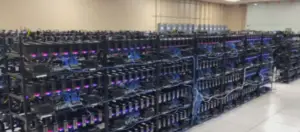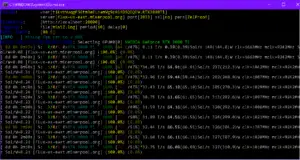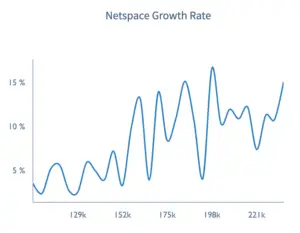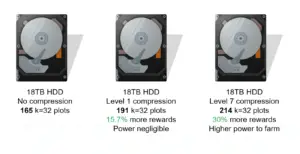Introduction to Conflux
Conflux is a fascinating blockchain, since it’s one of the few Proof-of-Work blockchains with EVM-compatibility. For those who are unfamiliar, this means that Conflux can use MetaMask, Web3.js, Solidity, Truffle, etc. — all tools originally designed for the Ethereum network.
This also means that dApps from Ethereum, Fantom, Polygon, and other EVM-compatible chains can be easily forked and deployed on Conflux. More specifically, these dApps would run on Conflux’s eSpace. This eSpace is a Proof-of-Stake chain that runs along with Conflux’s POW Core Space, and was introduced in the recent Hydra hard fork. This makes Conflux one of the only mineable EVM-compatible coins aside from ETH.
If you’re interested in mining Conflux, you’ve come to the right place. In this guide we’ll cover how to set up a Conflux wallet, configure mining software, and begin mining directly to your wallet.
First things first, you’ll need a capable graphics card such as Nvidia’s RTX 3070 or 3080. If you don’t have one already, it probably isn’t worth buying one for the express purpose of mining cryptocurrency; your breakeven time will be over two years at current rates unless you get a really great deal on a GPU.
See Also: How to Mine Any Cryptocurrency
- ~60MH/s Ethash
- ~61 H/s ZelHash
- ~28 MH/s ProgPow
How to Set Up a Conflux Wallet
Before getting started mining Conflux, you’ll need a wallet address to mine to. The easiest way to get an address is with a browser-based wallet. For this purpose, we’ll be using Fluent, an officially-recommended CFX wallet. Install it to your browser from this page. Conflux Portal is another solid alternative.
Once you’ve installed the plugin, open it up. You’ll be prompted to create a password. Be sure to write this down or, at the very least, don’t forget it.
Next, select New Seed Phrase in the UI. You’ll be given a list of 12 words. Write these down on a piece of paper and store it somewhere safe. If you lose this, you’ll lose access to your wallet with no recourse for recovery.
Now that your wallet is set up, you can send and receive Conflux. To receive CFX, copy the address located above the Send button within the wallet.

Choosing a Conflux Pool
The last step before setting up your miner is selecting a pool. You’ll definitely want to pool mine, as this is your best bet at consistent CFX rewards. You could go years without winning a block mining solo.
Finding a pool is easy. Head to MiningPoolStats’ Conflux page and find one with a reasonable percentage of the total network hashrate. In this article we’ll be using HeroMiners since they have over 15% of the total hashing power and have no fees (a ~1% pool fee is standard).

How to Mine Conflux
Mining Conflux is fairly easy, and a large number of miners support its Octopus hashing algorithm. We’ll be using NBMiner, but any Octopus-compatible software will do.
Begin by downloading the latest version of NBMiner. Make sure to get the correct version for your operating system. Unzip NBMiner’s files and extract them to an easy-to-access folder.
Within the folder, you’ll see a file named start_conflux.bat. Right-click on this batch file and select Edit to open it in Notepad or any text editor.
Now it’s time to edit the script to match your specific wallet address, pool, etc. The syntax should look like this:
@cd /d "%~dp0"
nbminer -a octopus -o stratum+tcp://<POOLNAME>:<PORT> -u <ADDRESS>.<WORKERNAME>
pauseThus, the finished product will look something like this (if you’re using HeroMiners):
@cd /d "%~dp0"
nbminer -a octopus -o stratum+tcp://us2.conflux.herominers.com:1171 -u cfx:aatz5xarcxd5znj33ayh3dy80ge0tmma2e9ng9zekf.RTX3080Ti
pauseAs a side note, you can find the best server for your location using the chart below. Acceptable ports are 1170 and 1171.

Save the .bat file and double-click on it to run. You’ll see a screen like the one below. Just like that, you’re mining Conflux. It will be paid out to your wallet when you hit your pool’s payout threshold.
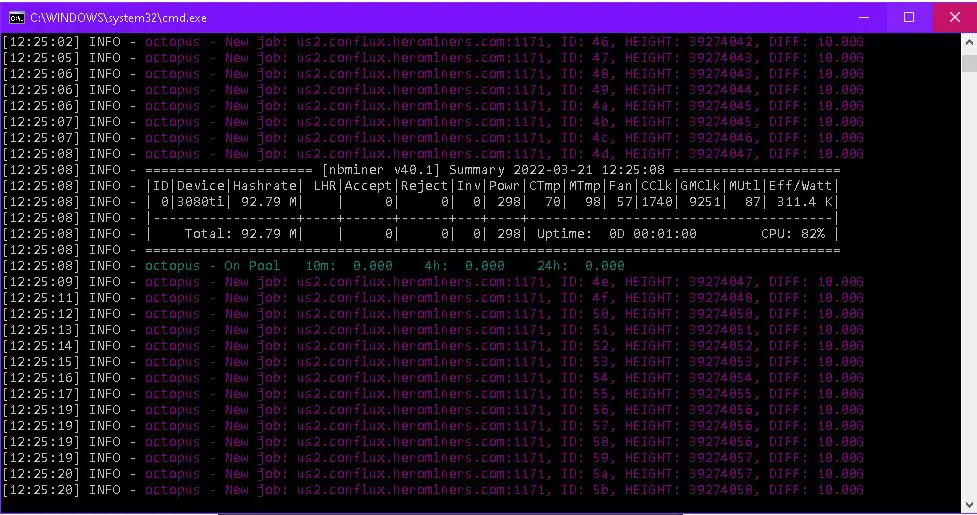
How to Sell Conflux
If you ever decide to convert your CFX balance to fiat, there are many ways to do this. Binance, OKX, and Gate.io all support CFX/USDT pairs, so you can liquidate your Conflux with either of these sites. Unfortunately, if you live in the United States these options aren’t available to you.
Luckily, Conflux has a decentralized bridge called ShuttleFlow that allows you to send CFX cross-chain to Ethereum, BSC, Okex, Huobio ECO, and Bitcoin. We recommend sending it from Conflux to BSC, where you’ll receive bCFX, a mirrored asset that you can then trade on PancakeSwap for an easier-to-liquidate asset like BUSD (for Binance.US), ETH, USDC, or USDT.
From there, you can send the balance to an exchange and convert it to fiat. The contract address for bCFX is:
0x045c4324039da91c52c55df5d785385aab073dcfAdd bCFX to PancakeSwap to exchange it for another token, or use this link to automatically import the address.
Admittedly, it’s a lot of work to liquidate Conflux, so it may not be worthwhile to mine unless you’re willing to keep in on-chain for use in CFX dApps (or those of chains supported by the ShuttleFlow bridge). If you’re looking for the highest possible return and easy liquidation, you may be better off mining Ethereum.

